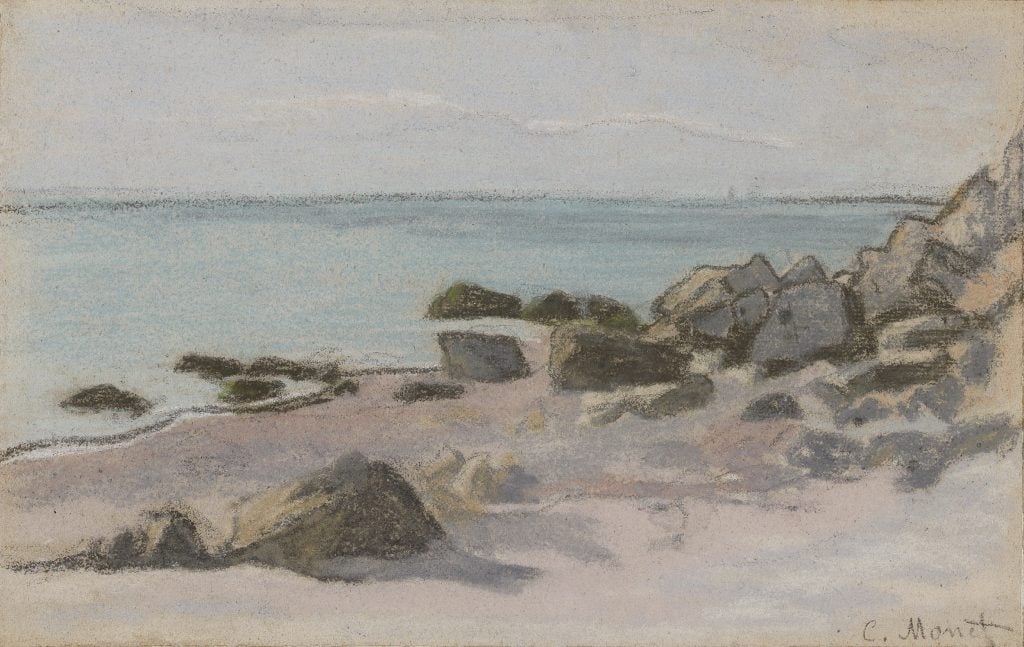Law & Politics
FBI Returns Nazi-Seized Monet to Owner’s Descendants
The restitution is the result of an 'amicable agreement' between all parties, according to gallerist M.S. Rau.

The restitution is the result of an 'amicable agreement' between all parties, according to gallerist M.S. Rau.

Adam Schrader

A small pastel work by Claude Monet seized by the Nazis during World War II is in the possession of the U.S. Federal Bureau of Investigation (FBI) to be returned to the descendants of its former owners.
The painting, Bord de Mer, had been acquired by Adalbert and Hilda Parlagi in April 1936 and kept at their home in Vienna, Austria, until they fled for Switzerland and then London with their two children shorty after Germany annexed Austria in March 1938.
The revelation that the painting was in the possession of U.S. authorities was made in a interpleader filing in a federal court on March 22. An interpleader is a way for one party to initiate a lawsuit between all parties who claim the right to a property to determine who has the rightful claim to it and avoid multiple liability.
The U.S. government acted as the plaintiff-in-interpleader to file the document as the possessor and distributor of the painting, likely to protect itself from legal claims against it during the process. The claimants of the property include Françoise Parlagi and Helen Lowe, who are the grandchildren of the Parlagis, and a couple other parties. Françoise and Helen are cousins and the only living heirs of Parlagis.
After fleeing the Nazis, the Parlagis stored the painting and other possessions in the warehouse of a shipping company in Vienna with the plan of either returning to retrieve it after the war or ship it to themselves.
But the German Gestapo seized their property in 1940 and it was auctioned by the Dorotheum auction house in 1941 and sold to another auction house owned by Adolf Weinmüller, a member of the Nazi Party who trafficked looted art.
After the war, the Parlagis and their heirs appealed to the post-war governments of Germany and Austria seeking the the return of the painting to no avail. The painting eventually appeared publicly again in a 2016 exhibition in Ornans, France, while on loan from the Galerie Helene Bailly in Paris.
The New Orleans-based antiquities dealer M.S. Rau purchased the painting from the Galerie Helene Bailly in 2017 and sold it to collector Bridget Vita and her now-deceased husband Kevin Schlamp in 2019.
The FBI researched the provenance of the artwork and seized it in June 2023, when Vita and Schlamp each waived their rights to the painting, the court documents read. The U.S. government is also not seeking the forfeiture of the painting into its own ownership.
A representative for Bill Rau, the third-generation owner of M.S. Rau, advised of the court case in an email and said his time has been working “diligently” with all parties to ensure the painting is returned to the rightful owners.
Until the painting can be handed over to the Parlagi descendants, the parties of the case are not allowed to discuss it. However, Rau received permission from the U.S. government to release a brief statement.
“All of the parties have reached an amicable agreement to happily return the pastel to its rightful heirs in light of the work’s provenance, which was of course completely unknown to all of the trading parties,” Rau said.
The New Orleans Field Office of the FBI is currently storing the work in a foam-lined, sealed container placed within a safe in the bureau’s fine-arts storage.